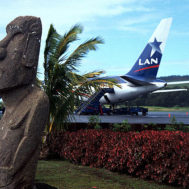Magnus Fiskesjö is a former director of the Museum of Far Eastern Antiquities, Stockholm, Sweden, a former Cultural Attaché at Sweden’s Embassy in Beijing, and currently an associate professor of anthropology, archaeology and Asian studies at Cornell University, USA.
An extensive bibliography and list of resources is appended at the end of this article.

Montage of satellite imagery of four mosques in northern Xinjiang. After 2018, three had been razed and the lot left vacant; the last had its domes and minarets removed (ASPI 2020).
The powerful testimonies presented at the Uyghur Tribunal in London on June 4-7, 2021, included discussion of China’s systematic destruction of Uyghur heritage. Newcastle anthropologist Jo Smith Finley spoke of an “identity castration”: the suffocation and destruction of all aspects of Uyghur living culture — including its material foundations.
This assault on heritage reveals the genocidal intent behind the Chinese campaign, and this was a key consideration when the British Parliament recently decided to condemn China’s actions as a genocide. This goes with other aspects such as the mass separation of families and the mass sterilizations, which are listed explicitly in the U.N. Genocide Convention (Article 2) as five basic examples of genocidal actions — and which have already clinched the case that what is happening is indeed a genocide.
As part of its multi-faceted campaign of terror, the Chinese regime is systematically bulldozing the material foundations of the history and identity of the Uyghurs and the other Xinjiang peoples — but, because cultural erasure (or, “cultural genocide”) isn’t included in the Convention, they have not often been discussed together with the other aspects. They should be.

The destruction of the historic Sultanim Cemetery in Hotan, between 2018 and 2019. From Bahram Sintash 2019 (for the parking lot, see imagery in AFP / Daily Mail, 2019).
The destruction includes both the Uyghurs’ famous holy pilgrimage sites called mazars, and thousands of mosques which are either razed, or neutered and transformed into restaurants or hotels. A recent case describes a Hilton hotel franchise going up on the site of a razed mosque.
Holy shrines are key sites of Uyghur peoples’ self-rejuvenation — and this is why China is destroying them. It is the same with graveyards, which similarly serve as a link between the past and future generations. Therefore, scores of both active and historical graveyards are razed and paved over. (No Uyghur would permit this, if they had any say in the “Xinjiang Uyghur Autonomous Region”!)
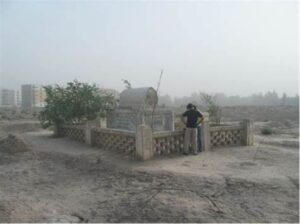
The tomb of Lutpulla Mutellip (1922-1945), famous Uyghur modern poet who was only 23 when executed by the Chinese. (From Chinese social media)
One example is the cemetery of Sultanim in the old city of Hotan, which dated to at least 960 AD, was destroyed in 2019, and turned into a parking area. This both disrupts families buried there, and the people’s sense of continuity with its history. Similarly, the gravesite of the modern Uyghur writer Lutpulla Mutellip was razed and made into a kitschy Chinese park. Modern statues of famous Uyghurs are also toppled, evidently with the same goal.
More broadly, the Chinese state campaign also targets vernacular architecture. As the architect Don Hanlon explains for the case of the Uyghur city of Turpan, tearing down native architecture is also to annihilate the culture. Much the same has played out in Kashgar, the cultural capital of the Uyghurs; and the few token fake Disneyfied spots designed to indulge domestic Chinese tourist do not make a difference, but rather highlight the erasure.

The cemetery where the poet Lutpulla Mutellip was buried, after the area was turned into a Chinese park. (From AFP / Daily Mail, 2019)
In a telling twist, one of the people selected to be put on display in the fake camps set up to fool gullible foreign journalists and diplomats about the coercive nature of the real mass camps, was later revealed to be an accomplished Kashgar heritage official, apparently detained precisely because of his pride in Uyghur culture.
It is also telling that Chinese archaeologists in the region of Xinjiang (or East Turkistan) have now been explicitly tasked with proving that the region was “always” part of China — even though already the Chinese name, New Frontier, reveals its recent origins in Chinese imperial conquest. Such commands go hand in glove with the regime’s sinister White Papers, which argue that Uyghurs never really existed as a coherent anything, only as an appendage to the Chinese empires.
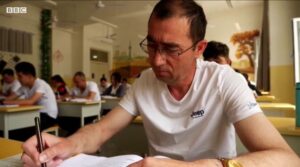
The Kashgar cultural heritage official accidentally included in a staged visit for foreign journalists, to a make-believe camp. (From Radio Free America 2019.)
Today, in stark contrast to the Chinese Communists’ past critique of the empires, they now emphasize past imperial glory, and the continuity with the modern Chinese nation. The China archaeologist Rowan Flad recently argued that Chinese archaeology was never imperialist, but this is wrong: It actually fits straight into a Chinese imperialist project, especially today, as the new official neo-nationalist and imperial narrative is being imposed not just in China, but in Central Asia and around the world. This fits hand in glove with the assertions of Chinese ownership of Southern Seas islands based merely on the discovery of Chinese pottery there, and this politicized archaeology strongly evokes the Kossinna-style expansionist archaeology of the Nazis in Germany, and beyond (cf. Fiskesjö 2016).

Chinese tourists entering the Disneyfied section of old Kashgar. Photo by Rian Thum, from Thum 2020, “The Spatial Cleansing of Xinjiang: Mazar Desecration in Context”)
Meanwhile, in the Uyghur region, even private homes are systematically targeted and inspected, and any ethnic interior home design is ordered destroyed. This includes not only religious items such as the mihrab (a decorated niche indicating the direction of Mecca), but any decorative patterns, and even things like the ingenious heated floor, the supa — which must be dug up.
Resistance is unthinkable — because of the threat of the draconian identity conversion camps, the family separations, the forced-labor schemes, and more. Indeed, every day is Kristallnacht.
And to frighten the entire population, the systematic physical erasure of Uyghur culture is accompanied by the mass forced disappearance of musicians and artists, writers, scholars, religious leaders, and other intellectuals, like my anthropologist colleague Rahile Dawut. All are likely detained in the new Gulag, alongside the vast numbers of anonymous, “ordinary” victims.
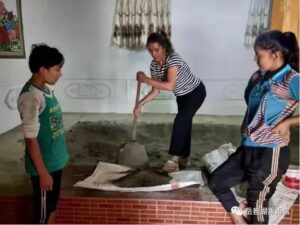
An Uyghur home where the supa is being destroyed. (From Chinese social media, captured by Timothy Grose; cf. Introvigne 2020)
Why is all this atrocious cultural erasure not a self-evident part of the Genocide Convention? Why is it that the term “cultural genocide” often used to describe it, is not in the Convention, and has no standing in international law?
Raphael Lemkin, the “father” of the U.N. Genocide Convention (1948), actually saw clearly that such acts — burning synagogues, burning books, and also disappearing the writers of those books — are part and parcel of what he called “genocide”: to erase a people as such, from the face of the Earth.
Yet in 1947-48 as the Convention was formulated, the former European colonial powers refused to include cultural erasure in the Convention’s definition of genocide — they were themselves guilty of similar conduct in their former possessions and did not want it brought up. The result is that Lemkin’s draft was cut, and acts like China’s current systematic bulldozing of mosques and mass arrests of poets and singers, are not explicitly part of the Convention except in how it says “whole or in part” which may be the survival of Lemkin’s concern with cultural figures (Cooper 2008).
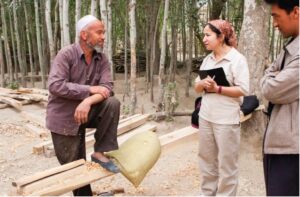
The Uyghur folklorist Rahile Dawut conducting research at a mazar shrine, ca. 2005. (Screenshot from Lisa Ross 2019)
But as the British Parliament saw, the systematic state-led destruction constitutes clear evidence of the Convention’s genocidal “intent.” The goal is to have no Uyghur culture for Uyghurs to lean on and sustain themselves into the future. All the various actions in the cultural arena work to block the transmission and inheritance of culture. Even in the absence of mass killings (other than of babies; and the many people who have died in the camps, of torture, starvation, or disease), the goal of China’s multifaceted campaign against the Uyghurs, Kazakhs and other peoples clearly is to eradicate them, as such, so that if there is a next generation, it will be Chinese instead. Then the genocide will be complete.
This is a key point. Yet there is more. Notwithstanding the limits of the Genocide Convention, let’s not forget that the acts of cultural destruction, often irreversible, are crimes in themselves. China’s government has promised to protect cultural heritage. And in the UN Human Rights Council, it has promised to respect cultural heritage as a human right — an obligation as solemn as that of the Genocide Convention. The compelling, unanimously adopted document condemns “all acts of unlawful destruction of cultural heritage,” as well as “the violation or abuse of the right of everyone to take part in cultural life, including the ability to access and enjoy cultural heritage,” — which is exactly what the Chinese government is doing today, to the Uyghurs and the Kazakhs, on a massive scale!

Raphael Lemkin (1900-1959) – a key force behind the U.N. Genocide Convention of 1948, who originally wanted cultural erasure to be part of the definition of genocide. (Source: United States Holocaust Memorial Museum website).
Even so, although the atrocities have been discussed at the UN, and multiple Special Rapporteurs have expressed great concern on different aspects of the genocide, they have been silent on the heritage destruction except for expressing concern as regards the brutal discrimination of the Uyghur language. Yet despite mounting evidence on all fronts, in the 5th year of the genocide, the UN has not yet appointed any probe of its own, not even on the violations of “cultural heritage as a human right.”
The international heritage bodies where China is a member, like UNESCO and ICOMOS, are silent. Even the new OurWorldHeritage group, which was supposed to push urgent issues when the official bodies are too slow, has chosen silence and inaction.
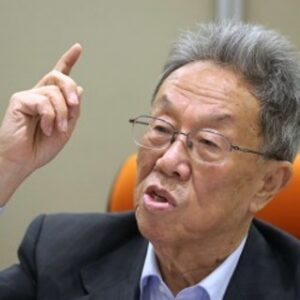
Chinese novelist and former culture minister Wang Meng, who lived in Xinjiang during the Mao period, in 2016 staunchly protested the Chinese government’s collective punishment of the entire Uyghur people. His voice has since fallen silent. (South China Morning Post, 2016; Roberts 2020 explains how the government deployed the rhetoric of anti-terrorism to launch its campaign of wholesale cultural destruction, and replacement).
This is a shame. The original hope with the UN and UNESCO was that we would rise above selfish intolerance. Here, the idea of world heritage originally also had great potential. We would all share in it and take responsibility for keeping it safe. Yet not much is left of these ideals now. World heritage seems reduced to just another cynical Olympic competition, and, worse, UNESCO itself appears to have been silenced by one powerful member state that now embodies selfish intolerance.
Meanwhile, other countries are making only token protests against China, including the long-repeated call for UN inspections in Xinjiang, even though it is clear that the Chinese government will continue to refuse to permit real access and stage-manage any visit. In effect, this is to postpone meaningful action. We have the facts, including on the cultural destruction, and we must take sufficient action to halt further atrocities, and irreversible destruction of cultural heritage.
As the genocide continues, the name of China as a country is increasingly tainted with the current regime’s crimes of intolerance. The regime is in effect adding China to the list of history’s worst heritage destroyers: Rome in Carthage; Turkey razing every last brick recalling an Armenian past; European settlers erasing the culture of the Indians of North America, the Nazis tearing down everything Polish; ISIS blowing up temples, and now China’s bulldozers. Chinese people, too, despite the regime’s formidable censorship, must begin to take note on what is being done in their name.
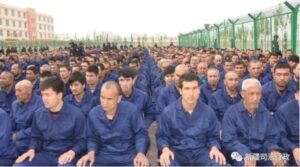
Detainees in the real brainwashing camps, where native languages are forbidden. Photo published by Chinese authorities to frighten the population still at large (From Chinese social media; taken down after circulating outside China)
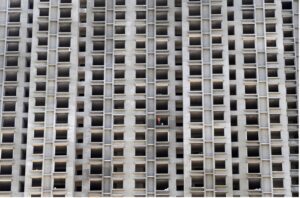
New housing in Xinjiang, China (From Hanlon 2019.)
Select bibliography and resources
(For more, see my online bibliography at: https://uhrp.org/bibliography/ and/or the Xinjiang Documentation Project, https://xinjiang.sppga.ubc.ca/ )

Ethno-tourism in Xinjiang, Three wax statues at the “Ethnic Minorities Exhibit” at the Xinjiang Uyghur Autonomous Region Museum in Ürümqi. One of the statues is supposed to represent a Uyghur man grilling kebabs; the statue next to him is of a female tourist posing next to him while making a peace sign, and standing opposite these two statues is another one of a male tourist taking a photo. Photo by Kubilayaxun, August 26, 2018
AFP. “Satellite Images Reveal China is Destroying Muslim Graveyards.” Daily Mail, Oct. 9, 2019. https://www.dailymail.co.uk/news/article-7553127/Even-death-Uighurs-feel-long-reach-Chinese-state.html (With a more complete photography selection than other papers)
Anderson, Elise. “The Politics of Pop: The Rise and Repression of Uyghur Music in China.” Los Angeles Review of Books 26, 2020. https://lareviewofbooks.org/article/politics-pop-rise-repression-uyghur-music-china/
ASPI. Cultural Erasure: Tracing the Destruction of Uyghur and Islamic Spaces in Xinjiang. By Nathan Ruser, Dr James Leibold, Kelsey Munro & Tilla Hoja. 24 Sep 2020. https://www.aspi.org.au/report/cultural-erasure [Companion website: https://xjdp.aspi.org.au/ ]
Bahram Sintash. “Demolishing Faith: The Destruction and Desecration of Uyghur Mosques and Shrines.” Washington D.C.: Uyghur Human Rights Project, Oct 28, 2019. https://uhrp.org/press-release/demolishing-faith-destruction-and-desecration-uyghur-mosques-and-shrines.html
Byler, Darren. In the Camps: China’s High-Tech Penal Colony. New York: Columbia Global Reports (October 2021). https://globalreports.columbia.edu/books/in-the-camps/
Cooper, John. Raphael Lemkin and the Struggle for the Genocide Convention. New York: Palgrave Macmillan, 2008. https://www.palgrave.com/us/book/9780230516915
Cotler, Irwin, and Yonah Diamond. “China’s Uyghur Genocide Is Undeniable.” Project Syndicate, June 3, 2021. https://www.project-syndicate.org/commentary/evidence-of-china-uyghur-genocide-by-irwin-cotler-and-yonah-diamond-2021-06
Crane, Brent. “Stolen By the State: Four Years Ago, A Famous Uyghur Anthropologist Disappeared.” Elle, May 21, 2021. https://www.elle.com/culture/a36421114/rahile-dawut-disappearance-china/ [About the folklorist Rahile Dawut]
Flad, Rowan K. “It’s a Golden Age for Chinese Archaeology – and the West is Ignoring it.” Washington Post, May 11, 2021. https://www.washingtonpost.com/outlook/2021/05/11/chinese-archaeology-egyptian-bias-sanxingdui/
Fiskesjö, Magnus. “Chinese Autochthony and the Eurasian Context: Archaeology, Mythmaking and Johan Gunnar Andersson’s ‘Western Origins.'” In Kathryn O. Weber et al, eds., Fitful Histories and Unruly Publics: Rethinking Temporality and Community in Eurasian Archaeology. Leiden and Boston: Brill, 2016, 303-320.
Fiskesjö, Magnus. “Michelle Bachelet Should Not Go to Xinjiang on Chinese Government Terms.” New Europe, May 6, 2021. https://www.neweurope.eu/article/michelle-bachelet-should-not-go-to-xinjiang-on-chinese-government-terms/
Fiskesjö, Magnus. “Forced Confessions as Identity Conversion in China’s Concentration Camps.” Monde Chinois 62 (2020), 28-43. https://www.cairn.info/revue-monde-chinois-2020-2-page-28.htm
Global Times. “Official Urges Archeologists to Prove Xinjiang Part of China Since Ancient Times.” March 23, 2017. https://www.globaltimes.cn/content/1039223.shtml
Guardian. “Revealed: New Evidence of China’s Mission to Raze the Mosques of Xinjiang.” May 7, 2019. https://www.theguardian.com/world/2019/may/07/revealed-new-evidence-of-chinas-mission-to-raze-the-mosques-of-xinjiang
Hanlon, Don. “The Case of Turpan, China: How to Destroy a Culture.” American Geographical Society Library blog, Oct. 3, 2019. https://agslibraryblog.wordpress.com/2019/10/03/the-case-of-turpan-china-how-to-destroy-a-culture/
Harris, Gareth. “New Heritage Body Aims to Keep UNESCO in Check.” The Art Newspaper, Nov. 16, 2020. https://www.theartnewspaper.com/news/new-heritage-body-to-keep-unesco-in-check-by-calling-on-public-to-help [About the new OurWorldHeritage organization]
Hiatt, Fred. “In China, every day is Kristallnacht.” Washington Post, Nov. 3, 2019. https://www.washingtonpost.com/opinions/2019/11/03/china-every-day-is-kristallnacht/
Ingram, Ruth. “Kashgar Destroyed: A Metaphor for China and the World.” Bitter Winter, June 6, 2020. https://bitterwinter.org/kashgar-destroyed-a-metaphor-for-china-and-the-world/
Introvigne, Massimo. “Uyghur Traditional Houses Destroyed by the CCP: Another Tool of Cultural Genocide.” Bitter Winter, July 11, 2020. https://bitterwinter.org/uyghur-traditional-houses-destroyed-by-the-ccp/
Pryor, Riah. “China’s Destruction of Uyghur Cultural Property Evidence of ‘Genocidal Intent’, UK MPs declare.” The Art Newspaper, June 2, 2021. https://www.theartnewspaper.com/news/chinese-destruction-of-cultural-property-evidence-of-genocidal-intent
Radio Free Asia (RFA). “Uyghur Detainee in BBC Video Report on Xinjiang Camps Identified as Cultural Official.” July 29, 2019. https://www.rfa.org/english/news/uyghur/official-07292019172310.html
RFA. “Xinjiang Authorities Remove Statue of Revered Uyghur Scholar Mahmut Kashgary.” Dec. 2, 2020. https://www.rfa.org/english/news/uyghur/scholar-12022020185652.html
RFA. “Mosque in Xinjiang’s Ghulja City Repurposed as Hotel.” April 29, 2021. https://www.rfa.org/english/news/uyghur/mosque-04292021181310.html
Roberts, Sean R. The War on the Uyghurs: China’s Campaign Against Xinjiang’s Muslims. Princeton: Princeton University Press, 2020.
Ross, Lisa. “Uyghur Holy Sites 2002-2011. Uyghur Holy Sites and the people who care for them. Witness who and what we are all losing.” Film, 9 min., 2019. https://vimeo.com/334691366 (also see https://www.studiolisaross.com )
South China Morning Post. “Xinjiang’s Uygurs ‘not radical Muslims’, says China’s former culture minister: Wang Meng, who spent 15 years in region before becoming culture chief, says the majority are smeared by actions of a tiny minority.” June 11, 2016. https://www.scmp.com/news/china/policies-politics/article/1971974/xinjiangs-uygurs-not-radical-muslims-says-chinas-former
Storozum, Michael J., and Yuqi Li. “Chinese Archaeology Goes Abroad.” Archaeologies 16 (2020), 282–309. https://link.springer.com/article/10.1007/s11759-020-09400-z
The Telegraph. “Hilton Hotel to be Built in Xinjiang after China Bulldozes Mosque.” By Sophia Yan. June 12, 2021. https://www.telegraph.co.uk/news/2021/06/12/hilton-hotel-built-xinjiang-china-bulldozes-mosque/
Thum, Rian. “The Spatial Cleansing of Xinjiang: Mazar Desecration in Context.” Made in China, 24 August 2020. https://madeinchinajournal.com/2020/08/24/the-spatial-cleansing-of-xinjiang-mazar-desecration-in-context/
Turdush, Rukiye and Magnus Fiskesjö. “Dossier: Uyghur Women in China’s Genocide.” Genocide Studies and Prevention: An International Journal 15.1 (2021): 22–43. https://scholarcommons.usf.edu/gsp/vol15/iss1/6/
United Nations. “Cultural Rights and the Protection of Cultural Heritage.” Resolution adopted by the Human Rights Council on 30 September 2016. 33/20 (UN Doc. A/HRC/RES/33/20). https://undocs.org/A/HRC/RES/33/20
United Nations. “Convention on the Prevention and Punishment of the Crime of Genocide.” Dec. 9, 1948. https://www.un.org/en/genocideprevention/documents/atrocity-crimes/Doc.1_Convention%20on%20the%20Prevention%20and%20Punishment%20of%20the%20Crime%20of%20Genocide.pdf
Uyghur Human Rights Project. Extracting Cultural Resources: The Exploitation and Criminalization of Uyghur Cultural Heritage. Washington D.C.: UHRP, June 12, 2018. https://uhrp.org/press-release/extracting-cultural-resources-exploitation-and-criminalization-uyghur-cultural
Uyghur Human Rights Project. Detained and Disappeared: Intellectuals Under Assault in the Uyghur Homeland. Washington D.C.: UHRP, May 21, 2019. https://uhrp.org/report/update-detained-and-disappeared-intellectuals-under-assault-in-the-uyghur-homeland/
Uyghur Human Rights Project. Kashgar Coerced: Forced Reconstruction, Exploitation, and Surveillance in the Cradle of Uyghur Culture. Washington D.C.: UHRP, June 3, 2020. https://uhrp.org/press-release/uhrp-report—kashgar-coerced-forced-reconstruction-exploitation-and-surveillance-cradle
Uyghur Tribunal, London, June 4-7, 2021. https://uyghurtribunal.com/ and https://www.youtube.com/channel/UCt4uc8LsgxsTDK_0dChZm5A
Vervaeke, Leen. “How China is Destroying the Uyghur Mosques.” de Volkskrant, June 12, 2021. https://www.volkskrant.nl/kijkverder/v/2021/how-china-is-destroying-the-uyghur-mosques~v440216/
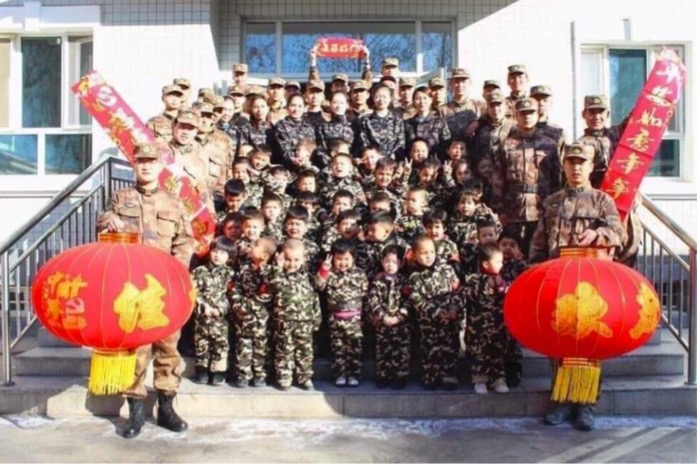 Chinese state propaganda photo of an "orphanage" for children confiscated from Uyghur concentration camp detainees, to deny them their culture and convert them into Chinese. (From Chinese social media).
Chinese state propaganda photo of an "orphanage" for children confiscated from Uyghur concentration camp detainees, to deny them their culture and convert them into Chinese. (From Chinese social media). 
